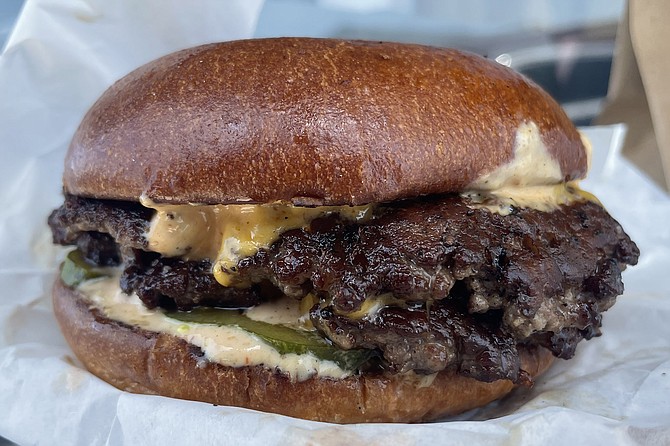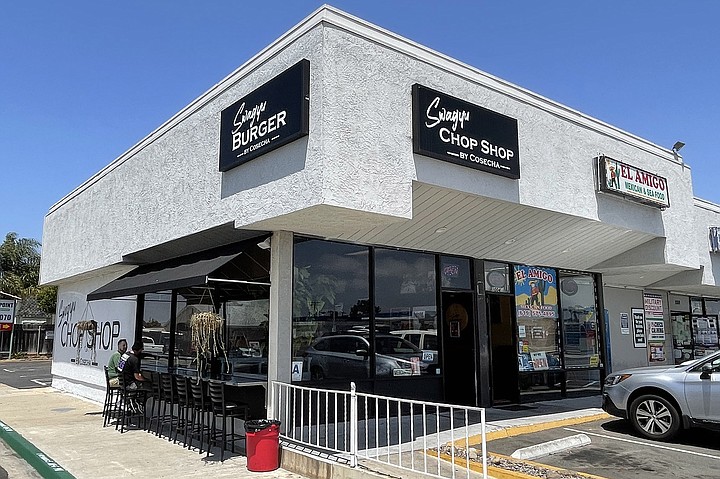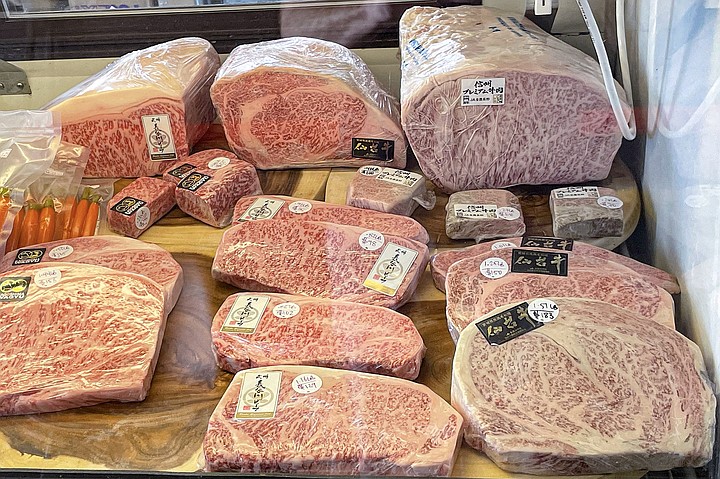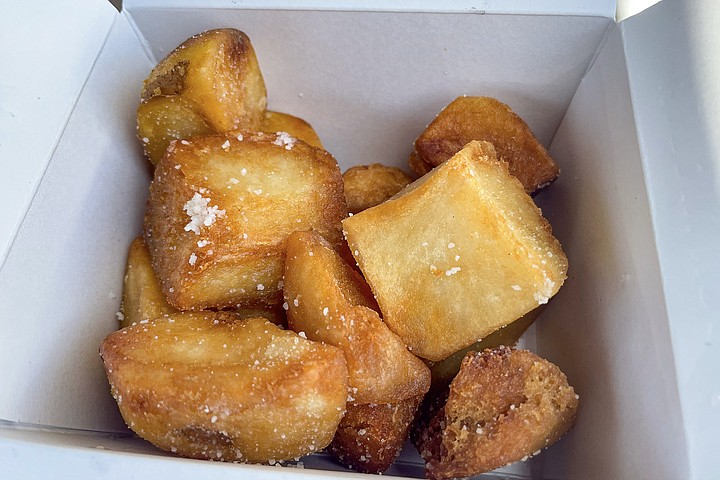 Facebook
Facebook
 X
X
 Instagram
Instagram
 TikTok
TikTok
 Youtube
Youtube

Here’s a surprising add to the list of things I never expected to do: agree to pay $18 for a cheeseburger, in Imperial Beach. Moments later, another: add a $10 side of fries.
And, no, I’m not talking about inflation gone awry (at least not entirely). For the most part there are valid reasons behind the price I paid. More valid than can be claimed by some of the pricey burgers found at the bottom of high-end steakhouse menus, at least.
Swagyu Chop Shop is not a high-end restaurant, though it is a particular kind of high-end butcher. The focus here is wagyu beef, primarily steak cuts that come from the prized lines of Japanese cattle lumped under the same name (wa means Japanese, gyu means beef).
Move over USDA prime, because wagyu cattle produces some of the most indulgent steak in the world, which gets its own grade: A5. This is noticeable in two ways when you peer into the glass meat case of Swagyu. First, the marbling. These cuts of beef aren’t merely marbled with flavorful fat; some literally look like small blocks of some rare Italian marble you might use to fashion upscale kitchen counters, only speckled with shades of pink and red.

The second, clear show of value is the price. The cheapest A5 I spotted here — the grain-fed Satsuma beef, raised in Japan’s Kagoshima prefecture — runs $110 per pound. Several examples of A5 beef are offered, sourced from prefectures with different feeding regimens.
At the top end were two lines priced at $190 a pound. One being the famous kobe beef, the Hyogo Prefecture cattle yielding rich, delicate meat often credited to a process that involves feeding the cows beer, giving them massages, and treating them to classical music. The other top cuts are of “Drunken A5,” from cattle raised on the Takamori ranch of Yamaguchi Prefecture, where cows are fed from a sake mash, said to be responsible for the silky texture found in their uber-marbled steaks.

You can find cheaper steaks in the case, cuts also taken from wagyu cattle, but raised in the U.S. or Australia. An Australian New York cut was going for $60 a pound. I spent $37 for eight-tenths of a pound of $46/lb, U.S.-raised New York strip. The U.S. filet mignon on the menu went for $91 a pound. The U.S. Tomahawk cut — bone-in ribeye — cost $150 a pound.
A small counter shop, Swagyu doesn’t cook these absurdly expensive steaks. But Steve Brown, the chef behind this and a second Swagyu shop in Poway (14149 Twin Peaks Road, Suite 5, Poway) did create a small menu built around that single entrée: the $18 burger.
It features meat ground from an undisclosed combination of Japanese, Australian, and American wagyu beefs. This is what brought me to Imperial Beach, to seek out a burger with the potential to be the best in San Diego.

I was a little surprised by the smashed style of burger I found. Two four-ounce patties are flattened, griddled, then stacked together with American cheese and house-made pickles on a brioche bun. It’s the willfully low-brow style of “dirty flattop” burger style that made North Park’s The Friendly made into a sensation a couple years back.
In other words, impossibly high-brow meat is being used to make a greasy diner style burger with processed cheese. And it’s delicious — even ground and caramelized on the griddle, you can tell the patties are more tender than most. It actually reminded me a little of an In-N-Out double double without the lettuce and tomato.
While I do consider this a must-try for burger fans — whether in North County or way south — I’d personally have liked more a chance to savor the pricey beef. Between the thin, griddled patties and generous sauce (a thousand island-like combination of ketchup, mayo, mustard, and relish) I didn’t find enough opportunity to focus on the renowned richness that makes wagyu so prized. A half-pound wagyu burger with a little pink in the middle would be nice.
But whoa, those ten-dollar fries exceeded expectations! Listed as “nitro potatoes”, they’re actually cubes of potato that are bathed in liquid nitrogen prior to hitting the deep fryer. I’m a little loose of my understanding of the science here, but as a result, moisture apparently collects at the outside of the potato when it fries, so the crust becomes assertively crispy, while the inside gets super fluffy. It’s like eating a three-dimensional potato chip wrapped around a potato puff. When I shared it with a ten year old I know, his immediate response was, “Whoever came up with this, is a genius!”
A combo of genius, swagger, and wagyu, I guess.


Here’s a surprising add to the list of things I never expected to do: agree to pay $18 for a cheeseburger, in Imperial Beach. Moments later, another: add a $10 side of fries.
And, no, I’m not talking about inflation gone awry (at least not entirely). For the most part there are valid reasons behind the price I paid. More valid than can be claimed by some of the pricey burgers found at the bottom of high-end steakhouse menus, at least.
Swagyu Chop Shop is not a high-end restaurant, though it is a particular kind of high-end butcher. The focus here is wagyu beef, primarily steak cuts that come from the prized lines of Japanese cattle lumped under the same name (wa means Japanese, gyu means beef).
Move over USDA prime, because wagyu cattle produces some of the most indulgent steak in the world, which gets its own grade: A5. This is noticeable in two ways when you peer into the glass meat case of Swagyu. First, the marbling. These cuts of beef aren’t merely marbled with flavorful fat; some literally look like small blocks of some rare Italian marble you might use to fashion upscale kitchen counters, only speckled with shades of pink and red.

The second, clear show of value is the price. The cheapest A5 I spotted here — the grain-fed Satsuma beef, raised in Japan’s Kagoshima prefecture — runs $110 per pound. Several examples of A5 beef are offered, sourced from prefectures with different feeding regimens.
At the top end were two lines priced at $190 a pound. One being the famous kobe beef, the Hyogo Prefecture cattle yielding rich, delicate meat often credited to a process that involves feeding the cows beer, giving them massages, and treating them to classical music. The other top cuts are of “Drunken A5,” from cattle raised on the Takamori ranch of Yamaguchi Prefecture, where cows are fed from a sake mash, said to be responsible for the silky texture found in their uber-marbled steaks.

You can find cheaper steaks in the case, cuts also taken from wagyu cattle, but raised in the U.S. or Australia. An Australian New York cut was going for $60 a pound. I spent $37 for eight-tenths of a pound of $46/lb, U.S.-raised New York strip. The U.S. filet mignon on the menu went for $91 a pound. The U.S. Tomahawk cut — bone-in ribeye — cost $150 a pound.
A small counter shop, Swagyu doesn’t cook these absurdly expensive steaks. But Steve Brown, the chef behind this and a second Swagyu shop in Poway (14149 Twin Peaks Road, Suite 5, Poway) did create a small menu built around that single entrée: the $18 burger.
It features meat ground from an undisclosed combination of Japanese, Australian, and American wagyu beefs. This is what brought me to Imperial Beach, to seek out a burger with the potential to be the best in San Diego.

I was a little surprised by the smashed style of burger I found. Two four-ounce patties are flattened, griddled, then stacked together with American cheese and house-made pickles on a brioche bun. It’s the willfully low-brow style of “dirty flattop” burger style that made North Park’s The Friendly made into a sensation a couple years back.
In other words, impossibly high-brow meat is being used to make a greasy diner style burger with processed cheese. And it’s delicious — even ground and caramelized on the griddle, you can tell the patties are more tender than most. It actually reminded me a little of an In-N-Out double double without the lettuce and tomato.
While I do consider this a must-try for burger fans — whether in North County or way south — I’d personally have liked more a chance to savor the pricey beef. Between the thin, griddled patties and generous sauce (a thousand island-like combination of ketchup, mayo, mustard, and relish) I didn’t find enough opportunity to focus on the renowned richness that makes wagyu so prized. A half-pound wagyu burger with a little pink in the middle would be nice.
But whoa, those ten-dollar fries exceeded expectations! Listed as “nitro potatoes”, they’re actually cubes of potato that are bathed in liquid nitrogen prior to hitting the deep fryer. I’m a little loose of my understanding of the science here, but as a result, moisture apparently collects at the outside of the potato when it fries, so the crust becomes assertively crispy, while the inside gets super fluffy. It’s like eating a three-dimensional potato chip wrapped around a potato puff. When I shared it with a ten year old I know, his immediate response was, “Whoever came up with this, is a genius!”
A combo of genius, swagger, and wagyu, I guess.
Comments